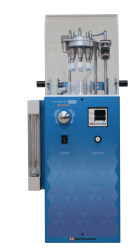Is Your Lab Equipment Wasting Energy? Breaking Down the Hidden Power Costs in Research Labs

Laboratories use 5–10 times more energy per square foot than standard office spaces (U.S. Department of Energy – Energy Efficiency in Laboratories). This excessive consumption is often tied to outdated equipment, inefficient routines, and small daily habits that go unchecked.
In this blog, we break down how and where labs waste energy—and what actions you can take to fix it. From smarter freezer settings to proper fume hood use, to more efficient evaporation techniques using tools such as energy-efficient evaporators, real examples from universities like Harvard and UC Davis show how small changes can lead to major energy savings.
Table of Contents
1. Where Is Energy Being Wasted in the Lab?
2. Rotary Evaporators vs. Smart Alternatives: A Power Use Comparison
3. Small Habits, Big Impact: Behavioral Fixes That Cut Energy Use
4. Smart Evaporator™: A Case Study in Energy Efficiency
5. Summary: Building a More Efficient Lab
1. Where Is Energy Being Wasted in the Lab?
Labs often consume more energy than necessary, much of it going unnoticed.
Equipment like rotary evaporators, centrifuges, fume hoods, and freeze dryers are frequently left running even when not in use. Older instruments also tend to lack energy-saving features. Misuse—such as running vacuum pumps without samples—exacerbates the issue.
The U.S. Department of Energy notes that laboratories are among the most energy-intensive facilities (U.S. Department of Energy – Energy Efficiency in Laboratories). At Harvard, the “Shut the Sash” campaign saved over $200,000 annually in electricity and reduced 300 metric tons of CO₂ emissions (Harvard University – Fume Hood Strategy White Paper). Similarly, UC Davis promotes raising ultra-low freezer setpoints from –80°C to –70°C as part of the Freezer Challenge, leading to energy savings of up to 30% while preserving sample quality (Freezer Challenge).
Recognizing energy-draining practices and improving both equipment and behavior can reduce energy use while supporting research goals.
2. Rotary Evaporators vs. Smart Alternatives: A Power Use Comparison
Not all evaporation methods are equally efficient—some consume significantly more energy.
Rotary evaporators typically require continuous operation of water baths and vacuum pumps. In contrast, newer evaporation technologies often use on-demand heating and sensor-triggered vacuum systems, minimizing idle power draw.
Studies suggest that traditional rotary evaporators can consume over 1 kWh per cycle. On the other hand, alternatives using targeted heat and sensor-based controls have demonstrated energy savings of up to 40%, depending on usage patterns. Among these, the Smart Evaporator™ stands out with its Vacuum Vortex Concentration (VVC) method, which applies focused heating and operates efficiently with minimal supervision, contributing to significant energy and labor savings.
Reassessing evaporation technologies allows labs to cut costs, reduce energy use, and improve research efficiency with precision-driven tools like the Smart Evaporator™.
Discover the Smart Evaporator™: The Safer, Simpler Solution for Solvent Removal
3. Small Habits, Big Impact: Behavioral Fixes That Cut Energy Use
| Behavior | Example | Energy Impact |
|---|---|---|
| Leaving fume hoods open | Ongoing air exhaust draws continuous power | Increased HVAC demand and CO₂ emissions |
| Running idle equipment | Centrifuges, evaporators, or pumps left on | Unnecessary electricity consumption |
| Ultra-low freezer settings too cold | Setting freezers to –80°C instead of –70°C | Up to 30% more energy used |
Simple behavior changes can have significant energy-saving effects.
Many sources of energy waste stem from everyday habits—such as leaving fume hoods open, using idle equipment, or setting ultra-low freezers colder than necessary.
Harvard’s “Shut the Sash” initiative reduced electricity use and CO₂ emissions by encouraging researchers to close fume hoods when not in use (Fume Hood Strategy White Paper). Similarly, UC Davis participates in the Freezer Challenge and promotes adjusting freezer setpoints to –70°C to cut energy usage by up to 30%, while maintaining sample viability (Freezer Challenge).
Educating lab members and enforcing simple policies can lead to meaningful savings with minimal investment.
4. Smart Evaporator™: A Case Study in Energy Efficiency

Accurate evaporation techniques can save energy and improve lab productivity.
Conventional systems often heat broadly and operate continuously, leading to high energy usage and increased risk to samples. The Smart Evaporator™ uses the Vacuum Vortex Concentration (VVC) method with a bead bath capable of heating up to 100°C, providing controlled, efficient evaporation.
Dr. Katsuragi at the Graduate School of Medical and Dental Sciences, Niigata University, reported that using the Smart Evaporator™ MT8 for blood and urine sample concentration reduced evaporation time by more than half compared to nitrogen blowdown. By running three sets of 8 samples daily with minimal variation and splash risk, her team significantly improved throughput and workflow reliability. (Full Testimonial)
Aligning energy consumption with actual workload enhances both sustainability and experimental throughput.
Discover the Smart Evaporator™: The Safer, Simpler Solution for Solvent Removal
5. Summary: Building a More Efficient Lab
Creating a greener lab starts with awareness and a willingness to make changes, both big and small. Whether it’s updating old equipment, encouraging better user habits, optimizing existing workflows, or redesigning entire procedures, each step contributes to lowering energy consumption, reducing environmental impact, and improving research efficiency.
Ready to Reduce Energy Use Without Compromising Research?
Explore energy-efficient solutions designed to meet your lab’s unique needs.
🔗 Explore Energy-Saving Evaporator
📚 Related Articles
- Rotary Evaporator vs Smart Evaporator: Principles and Key Differences👉 Read the full article here
- Maximizing Lab Efficiency: How Smart Evaporators Complement the Rotary Standard👉 Read the full article here
- Latest Trends in Evaporation Technology: What Equipment Will Laboratories Need in the Future?👉 Read the full article here
- Frustrated with Tedious Rotavap Work? Make Evaporation Easier Than Ever👉 Read the full article here
- Comprehensive Strategies for Effective DMSO Removal in Research Laboratories👉 Read the full article here
Sources
- U.S. Department of Energy – Energy Efficiency in Laboratories
- Harvard University – Fume Hood Strategy White Paper
- UC Davis – Freezer Challenge
- UC Berkeley – Green Labs Certification
